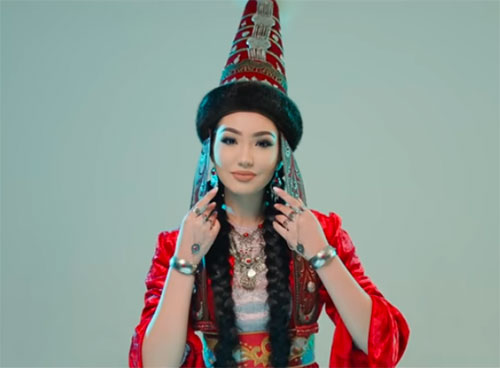 Kazakhstan is one of those Central Asian countries with rich traditions, a lot of which are still followed today. Including some of the local wedding traditions. Kazakh brides don’t always wear a folk wedding dress these days, but just a few decades ago, practically all of them did. And a wedding looked like a colorful and grand occasion, full of meaningful rituals, old traditions, and authentic symbols everywhere you looked. Let’s find out what a traditional Kazakh bridal attire is like, what materials it has to be made of, and what embellishments and jewelry they used.
Kazakhstan is one of those Central Asian countries with rich traditions, a lot of which are still followed today. Including some of the local wedding traditions. Kazakh brides don’t always wear a folk wedding dress these days, but just a few decades ago, practically all of them did. And a wedding looked like a colorful and grand occasion, full of meaningful rituals, old traditions, and authentic symbols everywhere you looked. Let’s find out what a traditional Kazakh bridal attire is like, what materials it has to be made of, and what embellishments and jewelry they used.
Kazakh people are nomads, and their lifestyle and traditions historically were dictated by this fact. For example, a lot of their clothing was produced from animal fibers and skins, which is typical for the nomadic cattle-breeding lifestyle. Other fabrics were made from available in the area plant fibers, like cotton, velvet (woven from cotton, silk, and other fibers), etc. Some fabrics were imported, and they, of course, were valued higher, thus, wedding garments were often sewn from such costly materials. The most popular fabrics used to make wedding attire were silk, velvet, brocade, satin, etc.
But not only the fabric matters in Kazakh wedding attire – every single detail of this costume has a deep meaning. First of all, the silhouette of a wedding dress has a trapezoid shape, which is symbolic in Kazakh culture and beliefs. If to talk about the color palette, the most popular color for wedding gowns was red – various shades of it, from pink to burgundy to purple, to scarlet, and so on. Red fabric was combined with gold and silver embroidery as fancy adornment. In some regions of Kazakhstan, green and blue fabrics were used as well, but they were not as widespread as red.
By the way, authentic Kazakh bride’s clothes had very long sleeves that covered the palms as well. Some ethnographers say that it was meant to show that the family was rich enough so that the bride never had to do the chores.
Kazakh wedding outfit of a bride was usually multilayered and looked rather modest. Her whole body was covered from the chin to the toes. Meters and meters of fabric were used to create those multiple garments worn one on top of the other. The attire didn’t look as delicate and body-hugging as wedding gowns are today, including modern Kazakh bridal dresses.
A very interesting part of Kazakh bridal attire was the headdress called “saukele”. It is a large, cone-shaped headpiece, richly embellished. It was really costly and showed off the wealth of the bride’s family. The headpiece was adorned with real precious stones, gold and silver coins, pearls, corals, tiny silver pendants, feathers, tassels, fur trimming, and other elaborate decorations. The artisans usually started working on the saukele about a year before the wedding because it took a lot of time and money to create it. The headdress also traditionally had long and intricate sort of pendants that were attached to the hat and hang to the waist of a bride. Very often, the bottom ends of such pendants were put into special pockets on the women’s dress because otherwise, they would tear under the weight because the pendants were made of beads, silver jewelry items, and other heavy elements put on a long thread.
Here are several beautiful examples of modern saukele in the RaiM & Artur (popular Kazakh rap artists) videoclip. Their song even is named “Saukele”. The link to this video is at the end of the article




Of course, the saukele wasn’t the only adornment worn by a Kazakh bride. She wore plenty of other jewelry pieces, including earrings, large silver necklaces or pendants, finger rings, decorative buckles on a belt, and various other options. Kazakh jewelers are actually very skilled with silver and precious and semi-precious stones, so they have always created real masterpieces.
Kazakh wedding rituals connected to wedding dress
There are a number of wedding rituals connected to the wedding outfit of a bride. For example, a so-called “bet ashar” is a ceremony of opening the bride's face. It happens during the wedding ceremony. The bride comes in covered by a large veil, and then, the veil is taken off at some point, accompanied by singing and playing dombra (Kazakh folk musical instrument). The groom lifts her veil with the tip of his dombra. After the bride shows everybody her face and is officially introduced to her new family, the wedding feast begins.
Another wedding ritual that reaches the wedding clothing takes place when the bride bids farewell to her parents’ house and leaves for her new home. She sings, gets a blessing from her family and friends, and her headdress is changed from taqiya (traditional simple skull-cap) to saukele (specific bridal headpiece). The bride’s father switches her headdress as a symbol of her transition from his little girl to a bride.
Photos are from: https://www.youtube.com/watch?v=EYT7cHxySUo

